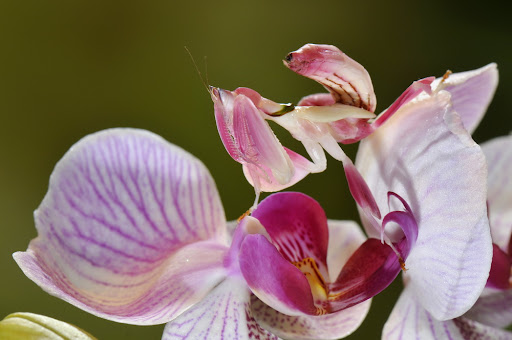Orchid mantis (Crowned Hymenopus)- one of the the brightest and most unique representatives of the insect world, known for its amazing mimicry. Due to its body structure and coloration, it almost completely imitates orchid, which makes it not only beautiful, but also an effective predator.
Its unusual appearance and rare behavior cause a passion among biologists, entomologists and lovers of exotic insectsIn this article we will take a detailed look at external features, behavior, habitat, feeding habits, reproduction and interesting facts about the orchid mantis.

Scientific classification
🔬 Classification of the orchid mantis:
✔ The Kingdom: Animals (Animalia)
✔ Type: Arthropods (Arthropoda)
✔ Class: Insects (Insecta)
✔ Row: Praying Mantises (Mantodea)
✔ Family: Praying Mantis (Mantidae)
✔ Gender: Hymenopus
✔ View: Orchid mantis (Crowned Hymenopus)
📌 Interesting!
Title Crowned Hymenopus it comes from the Greek words “hymen” (membrane, thin covering) and “crowned” (crowned), which emphasizes the elegant appearance of this praying mantis.
Appearance and unique features
💠 What does an orchid mantis look like?
• Size:
✅ Females – 60–70 mm
✅ Males – 40-50 mm
• Body shape:
✅ Flat body with large, rounded footpads
✅ Imitates flower petals
• Color scheme:
✅ From light pink to white
✅ Light yellowish or lilac shades on the tips of the paws
✅ Maybe change color depending on the environment
• Oko:
✅ Large, with excellent visual perception
• Front paws:
✅ Long, with sharp spines for capturing prey
📌 Interesting!
Orchid mantises can move their paws, imitating the swaying of flower petals in the wind.
Habitat and distribution
🌍 Where does the orchid mantis live?
This species is found in tropical forests of Southeast Asia.
✅ Countries of residence:
• Malaysia
• Indonesia
• Thailand
• Philippines
🔹 What places of residence does he choose?
✅ Jungle with high humidity and abundant vegetation
✅ Orchids and other flowering plants
✅ Tree branches where they grow tropical flowers
📌 Interesting!
Orchid mantises often choose white and pink orchidsto merge with them and hunt effectively.

Lifestyle and behavior
🏠 Camouflage and protection from predators
Orchid mantis uses passive and active mimicry.
❌ How it avoids predators:
✅ Excellent imitation flower petals, remaining unnoticed
✅ Slowly sways, imitating the movements of a plant
✅ In case of threat freezes or makes a sharp lungeto scare the opponent
📌 Interesting!
Its color may vary slightly depending on lighting, temperature and humidity.
🍽 Food and hunting
🔹 What do orchid mantises eat?
✅ Small insects – flies, butterflies, beetles
✅ Spiders and other arthropods
✅ Small frogs and lizards (in large females)
🔹 How do they hunt?
✅ Waiting for prey, sitting on a flower
✅ When an insect lands, quickly release front legs
✅ Hold the victim until they stop moving
📌 Interesting!
Butterflies and bees are easily trapped because they perceive the praying mantis as for a real flower.
Reproduction and life cycle
🔹 Mating season
✅ Males find females by the smell of pheromones
✅ After mating, the female lays eggs 100-200 eggs
🔹 Ootheca - egg capsule
✅ Attaches to branches or under leaves
✅ Protects larvae from drying out
🔹 Stages of development:
✅ Egg (2–4 weeks)
✅ Larva (nymph) – passes 6–8 lines
✅ Imago (adult praying mantis)
📌 Interesting!
Larvae in the early stages resemble little ants, which helps them avoid predators.

Threats and species status
⚠ What threatens the orchid mantis?
• Deforestation of tropical forests 🌳
• Use of pesticides 🧪
• Demand for exotic insects 🛒
🛡 Security status:
✅ In the wild quite rare
✅ Popular with terrarium keepers
📌 Interesting!
Due to its beauty and rarity, the orchid mantis is considered one of the most beautiful insects in the world.
Conclusion
Orchid mantis (Crowned Hymenopus) – a unique masterpiece of nature, combining spectacular appearance, perfect camouflage and predatory nature.
💡 Basic facts:
✔ Living twin of an orchid, which uses mimicry to hunt
✔ Impressive hunter, which easily catches insects
✔ Rare and beautiful, which makes it popular with collectors
✔ Lives in tropical forests, where it plays an important role in the natural balance
📢 The orchid mantis is a true miracle of nature, combining beauty and predatory behavior in a harmonious tandem!